Bohdana's first battle. How a Ukrainian Self-Propelled Howitzer forced the Russians to make a "gesture of goodwill" at Zmiinyi Island
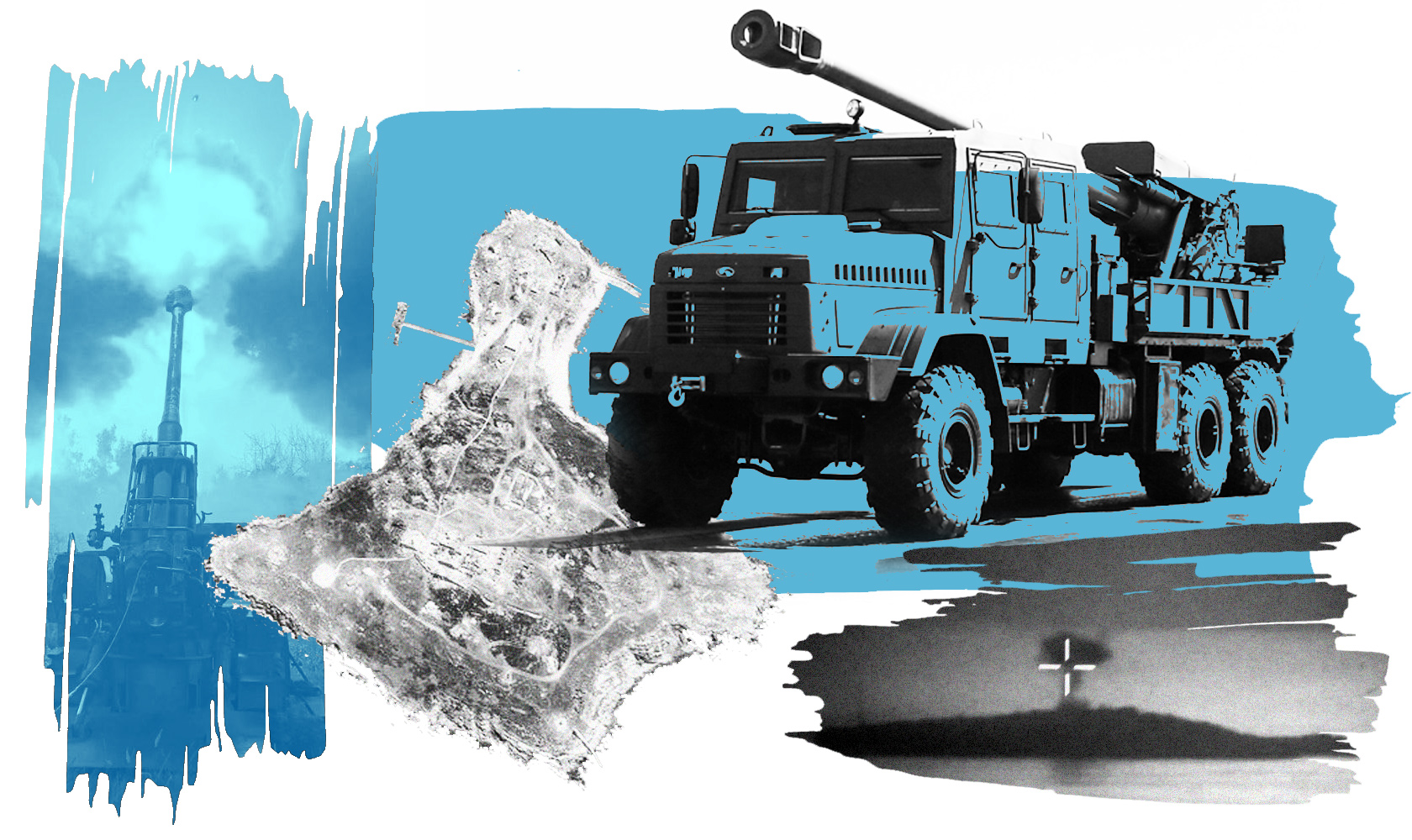
It was a hot day in early July 2022, which could have been the last one for Ukraine's only Bohdana Self-Propelled Howitzer (SPH).
Since early in the morning, the Ukrainian Armed Forces, who had been stationed on the edge of Ukraine in the Danube marshes for several weeks, had been moving Bohdana to another position. These marshes are a flat, open terrain where a team out of cover instantly becomes an easy target for Russian aircraft. So, it was necessary to act quickly.
As had been done dozens of times before, the self-propelled artillery system was loaded onto a pontoon from the shore of one of the Danube's branches. A small pier had been built on the other side of the river, where the 27-tonne SPH was to move to land.
"However, the road had not been prepared properly and the ground was very wet. Bohdana fell into this wet sand with its rear wheels, where the bulk of the weight is, and started sinking, and got bogged down. There was an attempt to take it out on their own, using engine torque, but the driveshaft could not take it," recalls lawyer Yevhen Hrushovets, who served as Bohdana's fire spotter in those days, in an interview with UP.
The heavy self-propelled artillery system was tilted to one side, and its barrel jutted out into the sky like a several-metre-long marker for Russian missiles. The team had no heavy equipment that could pull Bohdana out of the sand. The only option left is to leave the SPH where it was and try to find the necessary spare parts in the town of Vylkovo, Odesa Oblast.
The team quickly made a bush out of Bohdana, covering it with branches and camouflage nets, and leaving it lying on the shore. They sailed away on a small boat to look for spare parts, having no idea whether there would be anything to repair when they got back.
Fortunately, this entire nerve-wracking story took place after Bohdana and her French brother Caesar had forced the Russian garrison on Zmiinyi (Snake) Island to flee, or, as the Russians said, "to make a gesture of goodwill." [Russian propaganda claimed their retreat from the Zmiinyi island to be a gesture of goodwill, which eventually became a popular phrase in Ukraine to describe any withdrawal of Russian troops – ed.]
A few weeks earlier, a team of Ukrainian soldiers, showing miracles of ingenuity, had "taught" multi-tonne artillery units to literally walk on water, hide in an open field and, most importantly, destroy hostiles somewhere far out at sea, working beyond the tactical and technical characteristics.
Ukrainska Pravda offers its readers a reconstruction of this unknown fragment of the great battle for Zmiinyi Island.
The road to Zmiinyi: reassembling Bohdana, saving Kryvyi Rih
The heroic liberation of Zmiinyi Island might not have happened. After all, the only Bohdana manufactured in Ukraine was dismantled for parts at the very beginning of the full-scale invasion.
The design of Ukraine's self-propelled artillery system, which would fire a NATO-standard 155mm projectile, started during Petro Poroshenko's term in office. A fully assembled prototype of such a self-propelled artillery system, called Bohdana, was first paraded down Khreshchatyk [main street of Kyiv – ed.] during the 2018 Independence Day parade.
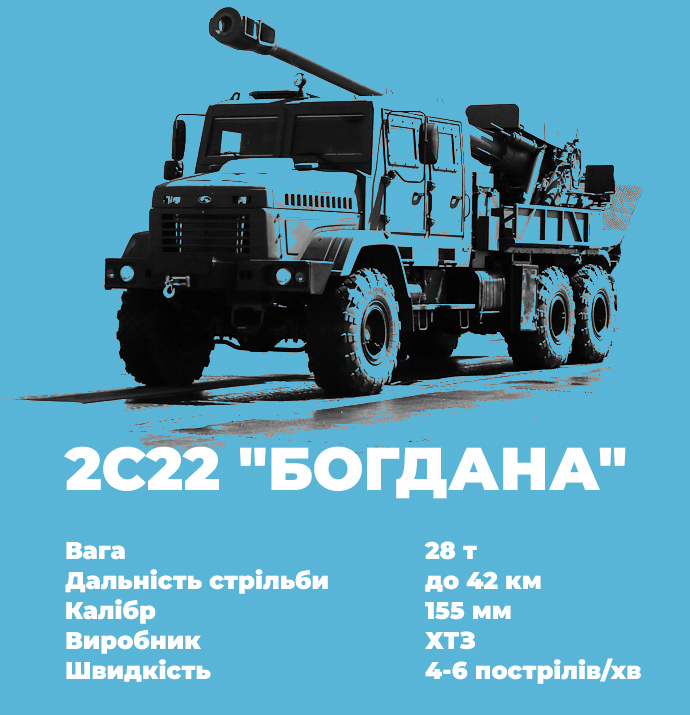
PHOTO: 2C22 Bohdana
Weight: 28 tonnes
Calibre: 155mm
Manufactured by: Kharkiv Tractor Plant
Firing rate: 4-6 rounds/minute
In the autumn of 2019, the production of the first full-fledged unit was completed and it passed the initial tests. However, these tests had not been fully completed by the beginning of 2022, and the first, and only, Bohdana was stored in a hangar in Kramatorsk, Donetsk Oblast.
At the beginning of the Russian invasion, the Ukrainian General Staff made a generally predictable decision to destroy all armament and advanced developments that could not be used and could potentially fall into Russian hands.

For instance, it was under this order that the frigate Hetman Sahaidachny, the flagship of the Ukrainian Navy, was scuttled at a dock in Mykolaiv Oblast during repairs.
Under the same order, Bohdana was dismantled into parts at a facility in Kramatorsk, where the barrel and other parts for the SPH were manufactured.
At this point, an unexpected character appears in the story, who would somehow accompany Bohdana throughout the events that followed. We are talking about Serhii Pashynskyi, former Chairman of the Committee on National Security and Defence Council of Ukraine.
President Zelenskyy called him a "100% criminal," and in early February 2022, the Supreme Court reopened the scandalous proceedings that were opened after Pashynskyi shot a man in the forest.
However, the former Member of the Ukrainian Parliament became active in Kyiv and Zhytomyr at the beginning of the invasion using the remnants of his former influence and connections. He was transporting missiles out of warehouses, getting Stuhna-P anti-tank guided missiles for the Territorial Defence Forces, and so on. He also arranged for the disassembled Bohdana to be transported to Zhytomyr.
There, specialists reassembled the SPH and started to put it in order.
"There wasn't plenty of work in Kyiv in my speciality. And in mid-April, I met the Bohdana team. I don't know how they learnt that I had been adjusting the artillery fire, but they said that they had Bohdana and needed a fire spotter who knew how to work with a drone," recalls Yevhen Hrushovets.
- I signed a contract with the Territorial Defence Forces, got acquainted with the team, these were the guys who had been on the tests [of Bohdana], and we went to the South."
Yevhen is a lawyer at a Kyiv-based company that once defended famous people, including Mikheil Saakashvili.
At the beginning of the invasion, Yevhen and his friends, who had no military status, observed Russian troops near Kyiv in the vicinity of the villages of Motyzhyn and Fasova. Later, they met artillerymen and other military personnel and coordinated Ukrainian artillery strikes on the occupiers' positions near Kyiv.
After Kyiv, Yevhen headed to Zelenskyy's hometown of Kryvyi Rih, where he met with the Bohdana crew. The Ukrainian SPH unit was part of the forces that stopped the Russian breakthrough toward the city in the spring of 2022.
"Bohdana and I met in Kryvyi Rih. I really liked her at first sight. She has armoured glass, and it has this very nice greenish tint. It's very beautiful. It gives you a sense of power. I told my wife that while she was away, I had already found somebody else, Bohdana," Hrushovets recalls with a smile.
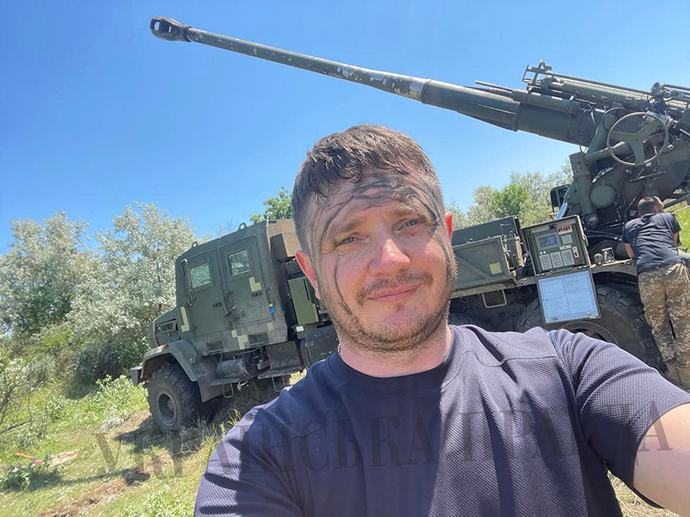
The team underwent its first combat drill near Kryvyi Rih. Bohdana had never participated in combat before, so the team was not even fully aware what this artillery system was capable of.
The first mission ended in a complete fiasco. The self-propelled artillery system made a few shots, but neither the crew nor the fire spotters using a drone could figure out where the shells hit. However, a few dozen shots, work at the training ground, and coordination of fire adjustment have been made, and Bohdana started to show that it could be a formidable weapon.
Near Kryvyi Rih, Bohdana team drilled to the point where they could hit the same spot several times over a distance of tens of kilometres.
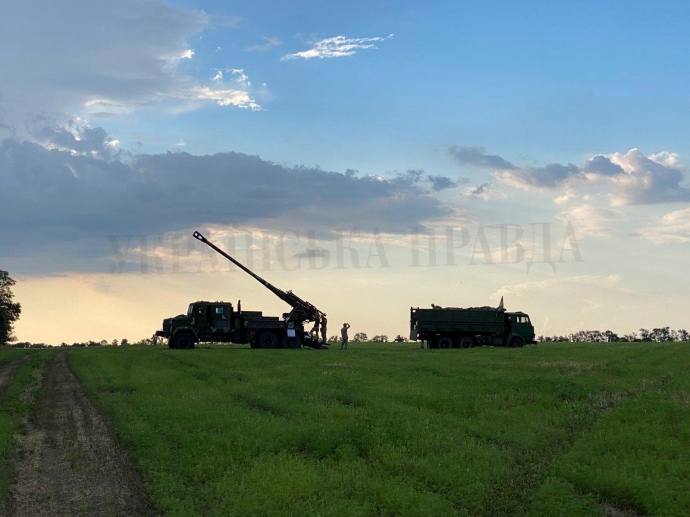
"One day I got a call asking if Bohdana could hit a 400-by-400-metre square. I responded: ‘Yes, it can’. Nobody else said anything more to me, but I realised the matter was about Zmiinyi. At that time, this topic of grain export was on the news. And when we went to Odesa Oblast the next day to conduct a reconnaissance mission, it was obvious that I had guessed right," Yevhen recalls.
"Bohdana" in the city on the water: preparations for the liberation of Zmiinyi
The conversation mentioned by Hrushovets took place in early June 2022. By that time, the battle for Zmiinyi had already taken several tragic turns.
After the Russians captured the island on 24 February, they made it an impregnable fortress in the middle of the sea. The main element of the Russian forces on Zmiinyi (Snake) Island was not so much the garrison located there as the huge amount of air defence.
Russian troops brought several new air defence systems and a powerful electronic warfare station to the island. Operating together, it did not let anyone approach the island either from the sea or from the skies.
Ukrainian forces tried to reach the island with everything they had but they did not have any significant success. Russian Pantsir-S and Tor anti-aircraft missile systems shot down both munitions from improved Ukrainian Verba MLRS and, what surprised the Armed Forces of Ukraine, even Tochka-U missiles.
At the beginning of May 2022, Ukraine managed to disable some of the air defence systems on the island, and attempted to land troops on Zmiinyi Island from the air and from the water simultaneously under the leadership of the Defence Intelligence of Ukraine.
Unfortunately, that assault did not bring any significant results and cost the lives of ten of the best Ukrainian paratroopers and Ihor Bedzai, Deputy Commander of the Ukrainian Navy. The defenders lost several units of equipment during the offensive as well, including boats and a helicopter.
It became obvious to the Ukrainian command that they had to look for some other, unexpected solution. And they found one when someone opened Google maps and figured out that it was less than 40 kilometres to Zmiinyi Island as per the nearest trajectory.
It meant that the island could be reached with both Ukrainian Bohdana and French Caesar self-propelled artillery units, the latter having already been supplied to Ukraine at that time.
"We have counted that the Bohdana’s range is more than 40 kilometres, that is, it would reach the island," said Myroslav Hai, who was a member of the Bohdana crew at the time, in a conversation with Ukrainska Pravda.
"But this is war, we need to get approval from Command. So, we gathered our belongings and went to Odesa to see Kovalchuk, the commander of Operational Command Pivden (South)," Hai recounted.
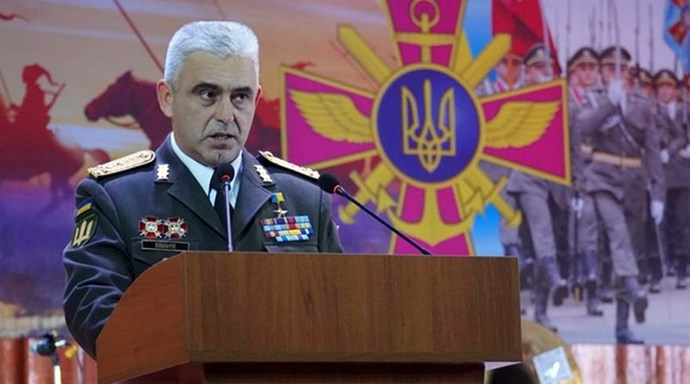
Oleksandr Ponomarenko, Chief of Operational Command Pivden’s artillery units, Mykhailo Podoliak, advisor to the Head of the President’s Office, Hai and Pashynskyi were present at the meeting with Major General Kovalchuk.
The general idea of the operation seemed quite simple: the Russians would not be able to shoot down an artillery shell, and both the Bohdana and the Caesar would actually reach the island.
It looked more than realistic in theory. The 56th brigade, local border guards and everyone who wanted to help were involved in implementing the operation.
The Bohdana crew went to Vylkove, a town on the water in the south of Odesa Oblast. The shortest distance to Zmiinyi was there, from the shore of the Ukrainian Venice town. But nature stepped into this military game all of a sudden.
Neither the Bohdana nor the Caesar could reach Zmiinyi from Vylkove itself. In order to target the island, it was necessary to install the artillery systems directly on the sea shore. Anyone who has been there knows that a cascade of islands and wetlands separates the town from the sea without any overland roads. The only way to the seashore is by water.
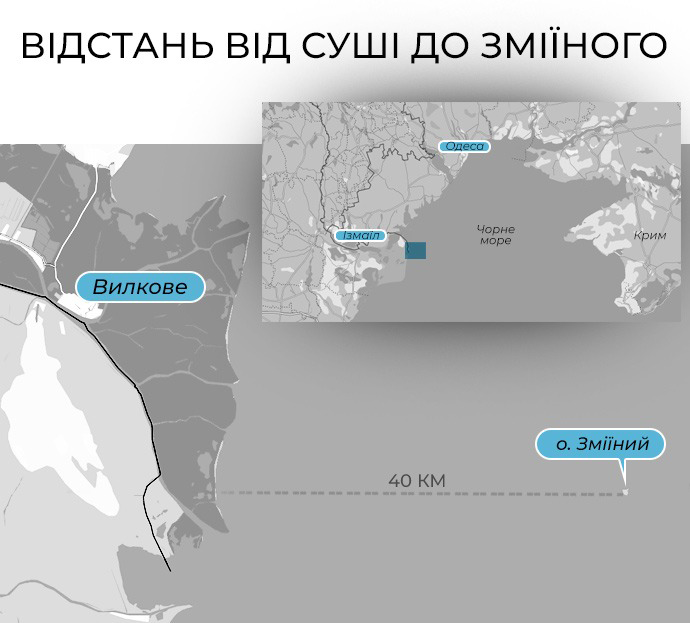
This issue was solved with pontoons that soldiers got from local businessmen. Every night, the Bohdana and Caesar systems were loaded on the floating platforms and floated 3-4 hours in one direction along the Danube and its branches to the designated positions.
The pontoons turned out to be very high, and the equipment could not land on the shore right away. So local border guards got a special water crane that was capable of making pits on the shore or creating small piers.
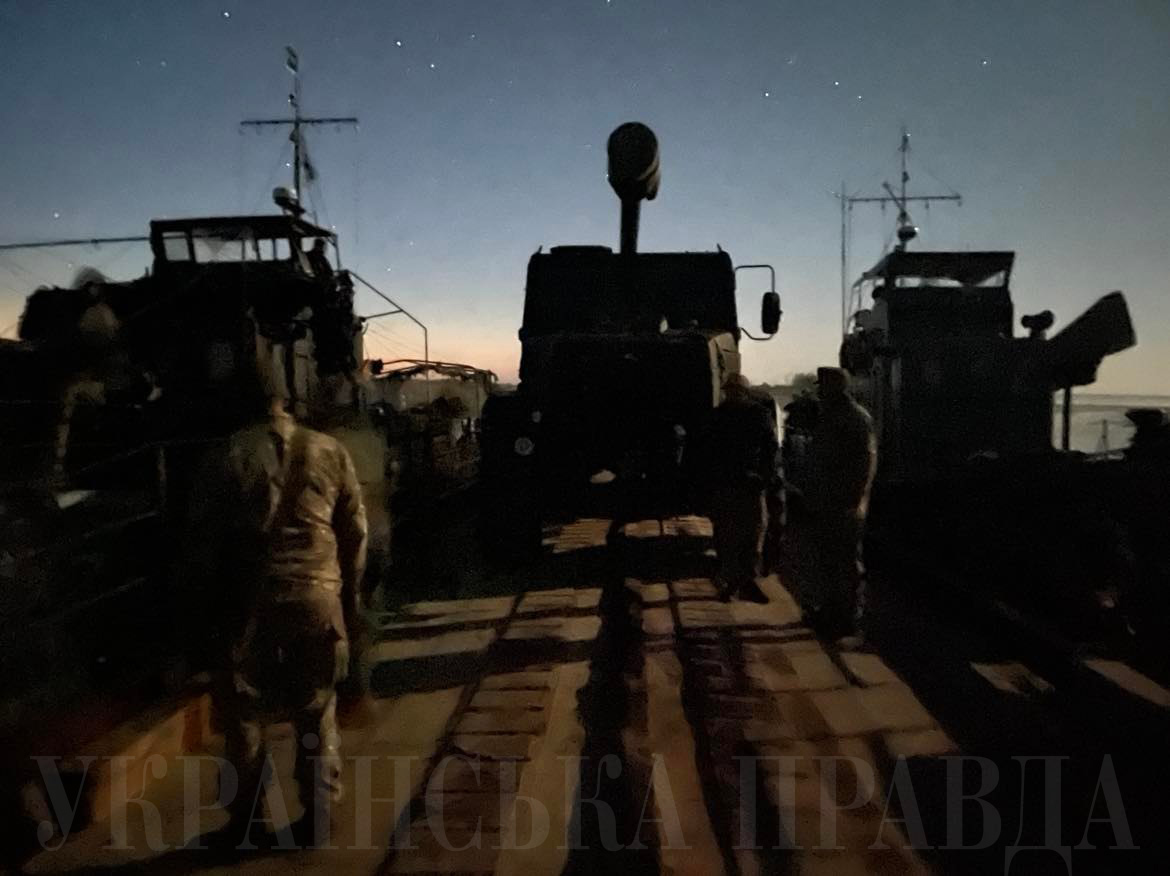
This crane belonged to local pro-Russian smugglers who fled Vylkove in the first days of the full-scale invasion. They used this equipment for their illegally constructed cottages on islands near the town. Now, the crane was put to work for victory – digging piers for pontoons, making crossings between various positions and places for the equipment to go over.
Rivers washed away embankments and destroyed piers every day, and the soldiers made them all over again every night.
The role of this Mammoth task was hard to overestimate. Wetlands are not exactly land. They consist of a layer of soil and plants 50-60 centimetres in width that floats on the surface and has water underneath. It is impossible to even dig a trench there because it is flooded with water right away.
Taking a Bohdana that weighs 27 tonnes or a Caesar that is 18 tonnes over such a surface seemed unrealistic. It was only due to local soldiers who knew every corner of those islands and wetlands that those self-propelled artillery units were able to literally go over the water.
The crew spent the first week of living in Vylkove raiding the local construction sector.
They bought chainsaws, tools, planks, nails, tents, ropes – everything that might come in handy while arranging discreet positions in wetlands.
Another problem was the mosquitoes who are naturally enormously large and very fierce there.
Several days were spent equipping shelters for the crew in bushes and shrubs. They also made camouflaged positions where they hid the artillery systems when they were not operating.
In order to confuse the Russian electronic warfare station and missiles, they hung various metal things on trees along the entire coast. When the Russians turned on their radars which were sensitive to metal, they saw the entire coast. Thus, it was much more difficult to detect two artillery units in the wetlands, even though they were big ones.
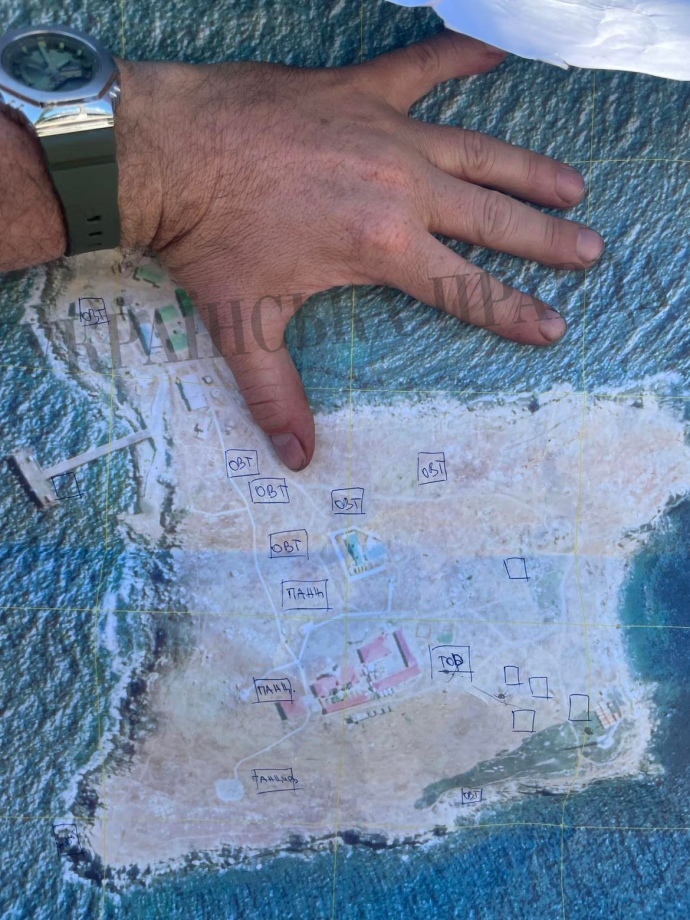
As of 16-17 June 2022, all the main preparations were almost completed. It was time for the artillerymen to take care of what had brought them there – liberating the island from the Russians.
"Monotonous destruction": "Bayraktars" in the skies, self-propelled artillery units on the ground
Early in the morning, if not overnight, on 17 June, the first Grad multiple-rocket launcher went over the pontoon route described above to the positions in the Danube wetlands.
On 19 June, two days later, the Bohdana went into position for the first time.
"We put down everything we had at hand – planks, trees. Because the Bohdana was ramming the sand and sinking. When the Caesar went at 4 am for the first time, its rear wheels sank into the sand, got stuck there, the Caesar started falling on its side, the pontoon moved away from its place, and everyone was in shock," recalled Yevhen, the Bohdana operator, recounting all the troubles of the operation.
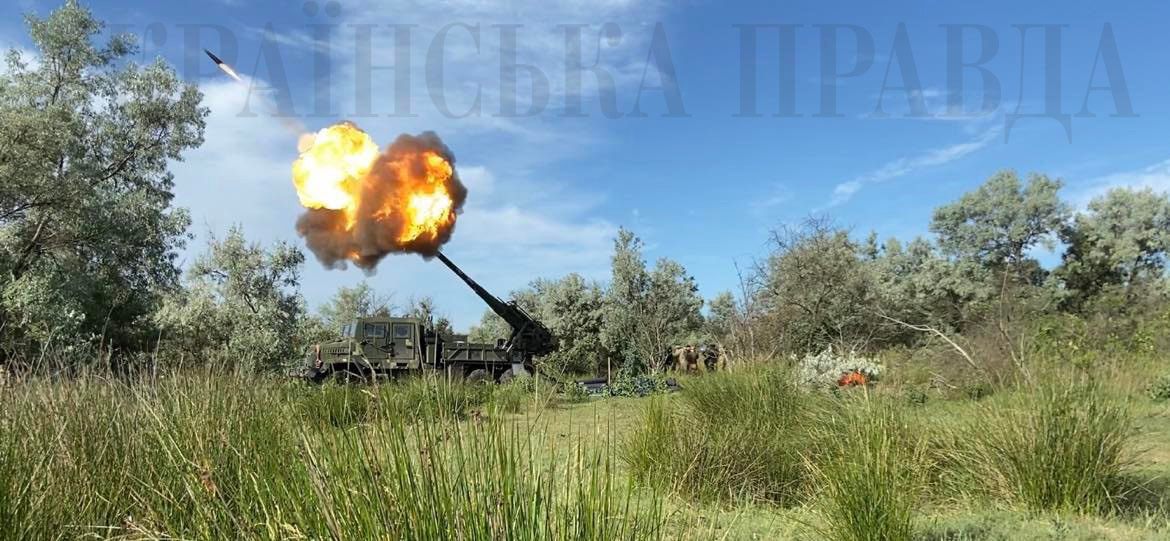
The operation could have ended without even having started. Nevertheless, the soldiers managed to take the Caesar onto firm ground by sunrise. The Bohdana, under which the ground had also sagged, was pulled out by its powerful engine.
But those were not the last inconveniences of the first day. When the artillery systems finally got to their positions and fired their first rounds at Zmiinyi Island, typical artillery issues started coming up.
After the first three shells, the sealing rings in the barrel of the Bohdana burned out. The Caesar gave up after the first 20 – the oil leaked.
The task required constant power from the equipment, and both artillery units had to work at the limit of their technical capabilities. But no one thought they would both give up on the very first day.
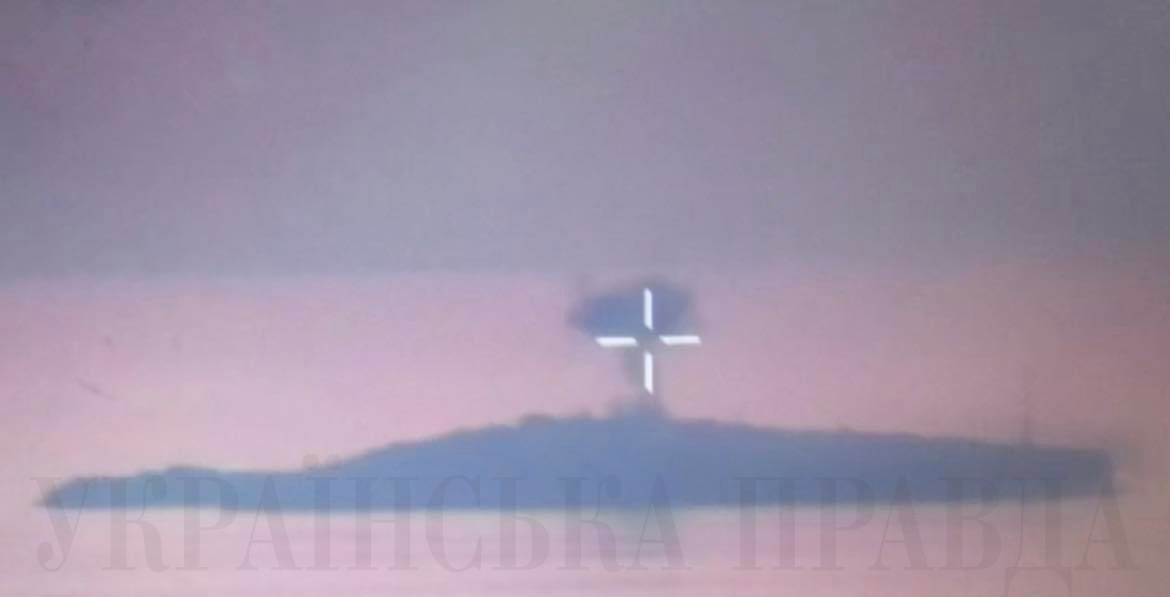
While the team was deciding how to send the units back for maintenance and what to do next, the Russians were not sleeping. Their aircraft struck the positions with several missiles on the first day. Fortunately, the strike was a few kilometres away from the place where the soldiers and border guards were at that moment.
"Our command gave us cover with the Buk anti-aircraft missile system. And we asked them not to shoot, but always keep the radar on so that the orcs can see that you are there. But the Russians struck us anyway. When we arrived where the strike was, a giant lake had been formed there," recalls Myroslav Hai.
When the units were repaired and both self-propelled artillery units returned to their positions again, the first shots set the following unexpected task for those involved in the operation: the spotters could not see where the shells were falling.
It turned out that the shells of the Caesar exploded not at the moment of impact on the surface, but 8 metres above it. This makes it possible to achieve maximum spread of wreckage and, accordingly, a larger area of damage. But when such a projectile explodes over water, the point of impact is almost invisible.
Especially when you consider the second problem – distance. The island is almost 40 kilometres from the coast. And it was impossible to fly up to it at a comfortable distance for observation.
The Matrix and Mavic, through which the island was watched from the shore, could not move far out to sea, because the Russian electronic warfare system tightly jammed the signal. And the Bayraktar could not provide a perfect picture, because it could not be allowed closer than 28-30 kilometres, otherwise it would fly into the Russian air defence zone.
This means that adjustments were made from two different places: on the shore, the team was guided by the data from their drones, and at the headquarters of Operational Command Pivden (South), the generals looked at the picture from the Bayraktar and corrected the strikes.

"If I see from our picture that there is a gap in the water in front of the island, it means that it has fallen short. I can see from the shore where we need to go left or right. Therefore, the Bayraktar was hovering on a perpendicular axis and had to adjust its fire to the depth of the island." explains Hrushovets in a conversation with Ukrainska Pravda.
However, before the start of the operation, it was impossible to carry out normal coordination between spotters on the shore and at the headquarters, so at first, there were "nuances".
"We see that they are wrong, but the generals are sitting there and ordering us to add "plus 400 metres", and I can definitely see that it is not necessary. We fired and nothing happened, clearly an overflight. In short, at some point I said, let me, on my own responsibility, try to fire as we see it. And how we started firing!" Hrushovets recalls with delight.
"Bohdana needs to feel how it shoots. There must be coherence between the spotter and the calculation. We already had this coherence," he explains.
"After the first few days of operation, Bohdana got the hang of it, confidently 'landed' on the ground, and at some point the team realised they could correct the hit by plus or minus 20 metres on an island 40 kilometres away.
It was especially easy when we smashed the radar and their air defence systems. It exploded so beautifully and for a long time! And then we realised that nothing was jamming the drone signal anymore," says the Bohdana spotter.
From the very beginning of the operation, the team separated the positions of the various artillery installations in the wetlands far apart, so as not to endanger them all at once from one strike. In addition, the self-propelled artillery units worked only in turn: Caesar would fire a little and hide, the Uragan self-propelled multiple-launch rocket system would fire, and then after it Bogdana fired.
All remnants of shells and shots were immediately collected and hidden, so as not to give away the location of the base.
And so it went on for more than a week, from 21 June to 30 June. When the air defence system was destroyed on the island, the Ukrainian version of the Grad multiple rocket launcher Verba was again used to destroy the Russian forces.
On the day of the" gesture of goodwill", 30 June, only the Bohdana was working in the morning. In fact, every shot hit Zmiinyi, which made the Russian garrison's presence there simply meaningless.
"We fired as many as 46 shots. A projectile takes 90 seconds to fly to the island. But you need some intervals so that the barrel has time to cool down a little. And so one by one we sent shells, such a monotonous system for destruction," Hrushovets recalls.
On the shift that morning, the team had 50 shells. The last four were saved in case the Russians brought reinforcements or an evacuation mission. And when they did arrive to pick up the remnants of their garrison in Crimea, four more powerful explosions were heard on the island.
At this point, Russia's control over the Ukrainian coast in this area could be considered completely lost. In a few weeks, Istanbul signed the "grain deal", where the Russian Federation actually recognized that it could no longer dictate conditions in the Ukrainian part of the Black Sea.
On the morning of one of the following days, the Ukrainian military on duty would see an incredible sight: several dozen huge cargo ships gathered between their positions and the island, like a flock of gulls flying for a piece of bread.
The massive ships were heading to the ports of Greater Odesa for bread.
***
"It was probably the scariest night. We thought that the Russians would definitely blow Bohdana to pieces. Well, we covered it, but it's a big piece of iron in the field. It was a piece of cake to find her," one of the military personnel involved in the operation recalls in a conversation with Ukrainska Pravda on the day of the breakdown described at the beginning of the operation.
But in the morning, the team found their self-propelled gun intact. Several hours of repairs and attempts to pull out the bogged-down Bohdana gave results. The unit got out of the sand.
Zmiinyi was liberated, so Bogdana[b][c][d][e][f] and her French counterpart were taken out of their positions and sent for repair.
Other Caesars were brought in to take their place, to patrol in case of any Russian movements. And in fact, as soon as Bohdana left, another missile strike hit one of the French units.
As the participants of that stage of the battle for Zmiinyi say, Caesar, like a true gentleman, covered Bogdana with his own armour.
"You know, Caesar is a super cool system. Modern, lots of electronics, powerful. But, like any good technique, it is a little too delicate for such conditions when you need to work beyond your capabilities. It put up a great show, although it was created for other tasks altogether," summarises one of the participants of the operation after several difficult weeks in June.
"Our Bohdana, because of its simplicity, could be repaired with a hammer on the spot. We had a situation when we took a part from a tractor in Vylkovo and put it on the Bohdana, and it worked perfectly.
I am sure that if we bring the existing Bohdana up to scratch, it will be one of the best units in the world. Its barrel is able to withstand constant firing with a maximum of 6 powder charges. Nothing else can do that," agrees Evhen Hrushovets.
The top military leadership of Ukraine thinks in the same vein. According to Ukrainska Pravda, Bohdana’s success on Zmiinyi aroused the special interest of President Zelenskyy.
Recently, Defence Minister Olexii Rezinkov posted a photo of a brand-new Bohdana made during missile attacks in Ukraine.
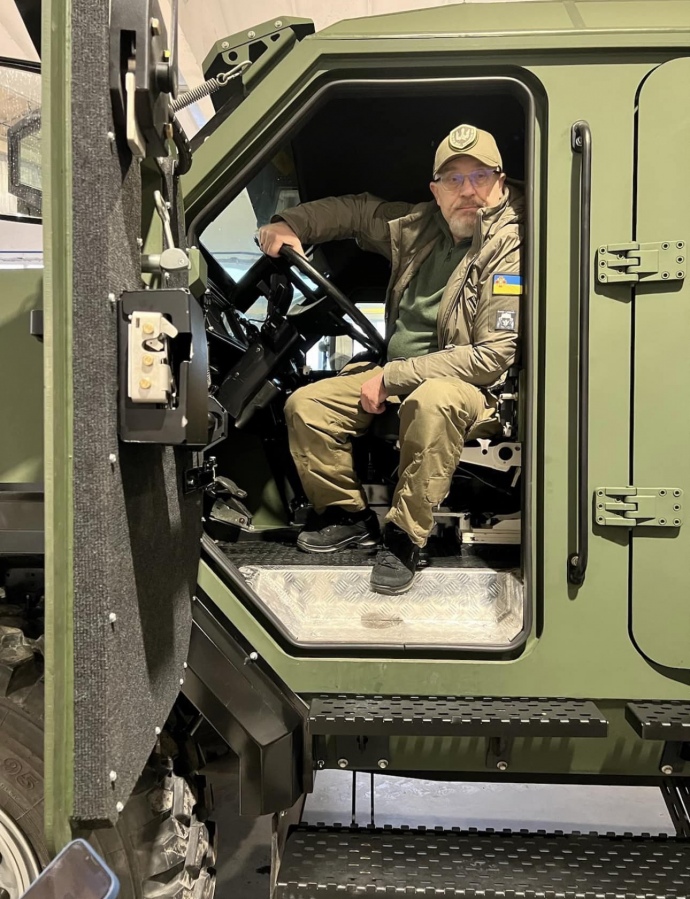
Back in the autumn of 2022, Ukrainska Pravda learned that the Ukrainian Self-Propelled Gun no longer exists as a single unit. Reznikov's message gives us hope that there will be more than one chapter in the history of Bohdana's victories.
Roman Romaniuk, Ukrainska Pravda
Translation: Artem Yakymyshyn, Myroslava Zavadska, Yelyzaveta Khodatska
Editing: Susan McDonald